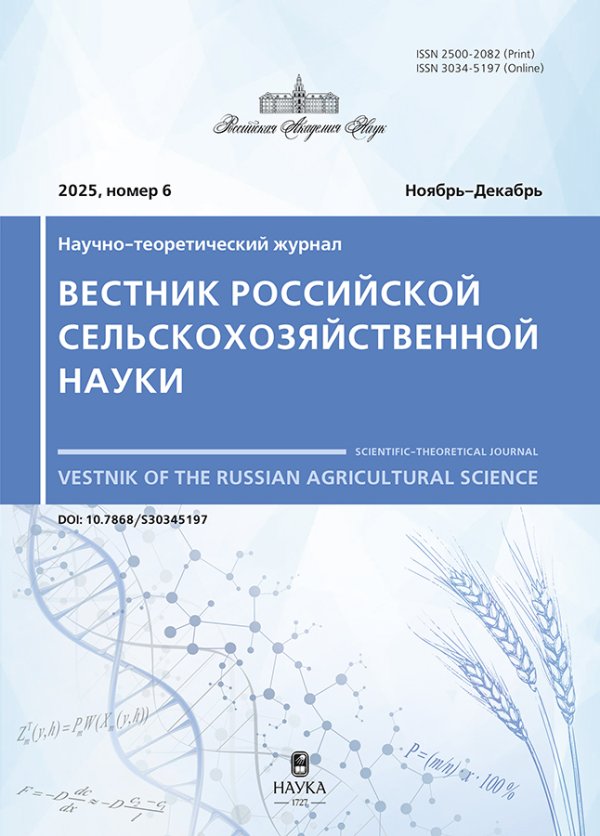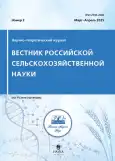Effects of greenhouse conditions on pollen viability of remontant raspberry
- Authors: Kiseleva E.N.1, Rachenko M.A.1, Rachenko A.M.1
-
Affiliations:
- SIFIBR SB RAS
- Issue: No 2 (2025)
- Pages: 40-46
- Section: Crop Production and Selection
- URL: https://journals.rcsi.science/2500-2082/article/view/293860
- DOI: https://doi.org/10.31857/S2500208225020099
- EDN: https://elibrary.ru/HUSWNB
- ID: 293860
Cite item
Abstract
The article presents the results of the study of the genotype influence, as well as the cultivation conditions of remontant raspberries on the pollen viability. The studies were carried out in 2021–2023 at the collection site of the Bioresource Center of the Siberian Branch of the Russian Academy of Sciences (Irkutsk). The object of the study is raspberry varieties with a remontant type of fruiting, grown in open ground and greenhouses with film and polycarbonate covering. The quality of pollination directly correlates with the productivity of the crop. We investigated the relationship between the pollen viability collected at different times and under different cultivation conditions (open and closed ground) and the productivity of remontant raspberry plants. In open ground, high pollen viability was noted during the period of mass flowering (August 1) – 71.8 ± 7.86%, in a greenhouse with a polycarbonate covering from August 1 to September 1 – 74.5 ± 6.42 ... 75.9 ± 9.78%. Correlation analysis showed the influence of pollen viability on the fruit quality and plant productivity from 1 m2. The correlation coefficient in all variants tends to one and can be assessed as strong. According to the determination coefficient, the relationship between pollen viability and fruit weight is 98%, fruit size – 68%, productivity – 92%. The results can help in developing optimal conditions for cultivating crops in closed ground and selecting a flexible variety.
Full Text
About the authors
Elena N. Kiseleva
SIFIBR SB RAS
Author for correspondence.
Email: bigmks73@rambler.ru
PhD in Agricultural Sciences, Researcher
Russian Federation, IrkutskMaxim A. Rachenko
SIFIBR SB RAS
Email: bigmks73@rambler.ru
Grand PhD in Agricultural Sciences, Chief Researcher
Russian Federation, IrkutskAnna M. Rachenko
SIFIBR SB RAS
Email: bigmks73@rambler.ru
Lead Engineer
Russian Federation, IrkutskReferences
- Akimova S.V., Vikulina A.N., Demenko V.I. i dr. Nesezonnoe proizvodstvo yagodnoj produkcii maliny krasnoj v usloviyah otaplivaemyh zimnih teplic. Ovoshchi Rossii. 2019. № 5. S. 58–66. https://doi.org/10.18619/2072-9146-2019-5-58-66
- Vasekha V.V., Kozlovskaya Z.A., Vasil’eva M.N. i dr. Rekomendacii po podboru sortov-opylitelej dlya sovremennogo sortimenta plodovyh kul’tur i funduka // Plodovodstvo. 2016. T. 28. S. 245–255.
- Gavrilova O.A., Tihonova O.A Kachestvo pyl’cy vidov i otdalennyh gibridov v semejstve grossulariaceae dc // Agricultural sciences. Uspekhi sovremennogo estestvoznaniya. 2016. № 12. S. 68–73. https://s.natural-sciences.ru/pdf/2016/12-1/36263.pdf
- Gorina V.M., Mesyac N.V. Zhiznesposposobnost’ pyl’cy abrikosa. Plodovodstvo i yagodovodstvo Rossii. 2017. № 51. S. 13–16. https://www.plodovodstvo.com/jour/article/view/275
- Gribanovskaya T.V. Biologicheskie osobennosti pyl’cy nekotoryh plodovyh kul’tur // materialy Mezhdunarodnoj nauchno-prakticheskoj konferencii molodyh uchenyh. Michurinsk. 2000. Ch. 1. S. 20–25.
- Zamburova D.S., Sherieva S.A., Sitnikov M.N. i dr. Izuchenie zhiznesposobnosti pyl’cy plodovyh kul’tur posle vozdejstviya sverhnizkih temperatur // Sovremennye problemy nauki i obrazovaniya. 2016. № 3. URL: https://science-education.ru/ru/article/view?id=24849
- Kiseleva E.N., Rachenko M.A., Kamyshova L.E., Rachenko A.M. Ocenka sortov i form remontantnoj maliny po skorospelosti v usloviyah Predbajkal’ya / Mat. II mezhd. nauch. – prakt. konf. «genomika i sovremennye biotekhnologii v razmnozhenii, selekcii i sohranenii rastenij». 2021. S. 187–188. https://elibrary.ru/item.asp?id=47461819
- Kiseleva E.N., Rachenko M.A., Rachenko A.M. Ocenka perspektivy vozdelyvaniya remontantnoj maliny v zakrytom grunte v usloviyah Yuzhnogo Pribajkal’ya / Mat. mezhd. nauch.-prakt. konf., posvyashch. 70-letiyu so dnya rozhdeniya dokt. s-h nauk, professora V.I. Soloduna / Irkut. gos. agrar. un-t im. A.A. Ezhevskogo; Molodѐzhnyj: Izd-vo Irkutskij GAU. 2022. S. 115–125. https://irsau.ru/structure/science/materialy/10-202022.pdf
- Marakaeva T.V., Kazydub N.G Opredelenie zhiznesposobnosti pyl’cy fasoli obyknovennoj (Rhaseolus vulgaris) v raznoe vremya sutok v usloviyah yuzhnoj lesostepi Zapadnoj Sibiri // Advances in current natural sciences. № 6. 2016. S. 96–99. https://s.natural-sciences.ru/pdf/2016/6/35973.pdf
- Cacenko L.V., Kerimov R.V. Pyl’ca rastenij i ee harakteristiki v usloviyah menyayushchegosya klimata // Nauchnyj zhurnal KubGAU. 2023. № 186(02). S. 1–15. http://ej.kubagro.ru/2023/02/pdf/18.pdf
- Yandovka L.F., Deeva L.A. Biologicheskie osobennosti pyl’cy nekotoryh predstavitelej rodov Malus, Cerasus, Pyrus i Sorbus v svyazi s UF oblucheniem // Vestnik rossijskih universitetov. Matematika. Vestnik TGU. 2004. T. 9. S. 35–39. https://cyberleninka.ru/article/n/biologicheskie-osobennosti-pyltsy-nekotoryh-predstaviteley-rodov-malus-cerasus-pyrus-i-sorbus-v-svyazi-s-uf-oblucheniem
- Yandovka L.F. Fertil’nost’ pyl’cy u vidov Serasus i Microcerasus (Rosaceae) // Agrarnyj vestnik Urala. 2010. № 6 (72). S. 58–61. https://cyberleninka.ru/article/n/fertilnost-pyltsy-u-vidov-cerasus-i-microcerasus-rosaceae/viewer
- Åsa Lankinen, Sandra A M Lindström, Tina D’Hertefeldt Variable pollen viability and effects of pollen load size on components of seed set in cultivars and feral populations of oilseed rape // PLoS One. 2018. № 13(9). https://doi.org/10.1371/journal.pone.0204407
- Asilbeyova T.M., Gavrilova Olga. Pollen morphology of the genus Rubus L. (Rosaceae) from Azerbaijan. 2019. https://www.researchgate.net/publication/339398504_Pollen_morphology_of_the_genus_Rubus_L_Rosaceae_from_Azerbaijan
- Asilbeyova T., Gavrilova O., Krasovskaya L. Pozhidaev A. Palynomorphological study of Azerbaijanian Rubus species in comparison with the morphology of pollen of the whole genus. 2023. https://doi.org/10.21203/rs.3.rs-3574701/v1
- Chen L.Y., Xiao X., Xiao J. Flower and reproductive characteristics of different large-flowered taxa of Epimedium. J. Plant Res. 2019. № 39. PP. 808–816. https://doi.org/10.7525/j.issn.1673-5102.2019.06.002
- Gavrilova O.A., Tikchonova O.A. Apertural pollen types in the Grossulariacae family // Аbstr.6 th Balkan Botanical Congress: Book of abstracts – Rijeka. Croatia. 2015. PP. 25.
- Lankinen Å. In vitro pollen competitive ability in Viola tricolor: temperature and pollen donor effects // Oecologia. 2001. № 128. PP. 492–498. https://doi.org/10.1007/s004420100681
Supplementary files















